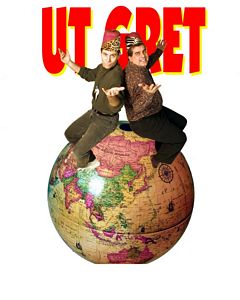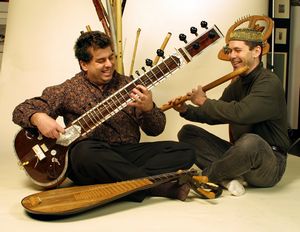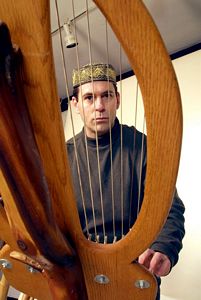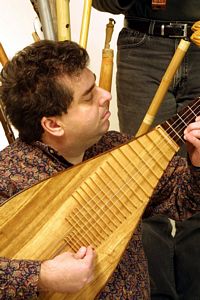social bookmarking tools:
 |
|
| Available RSS Feeds |
|---|
 - Top Picks - Top Picks |
 - Today's Music - Today's Music |
 - Editor's Blog - Editor's Blog
|
 - Articles - Articles
|
Add Louisville Music News' RSS Feed to Your Yahoo!
|
(OR: UT GRET PLAYS SONGS OF LOVE AND THE
TRANSFORMATIONAL GRAMMAR OF IMPROVISATION FOR YOU)
Don't ask for the meaning, ask for the use.
-- Ludwig Wittgenstein
It's an energetic rendition of the old Donovan song "Epistle to Dippy" played by a banjo, sitar, organ, soprano sax, bass and drums. The vocalist forces a crisp British accent into the lyrics. Before you can adjust to the odd instrumentation for a song that might best be blasted out by a punk band practicing in a neighborhood garage, it tumbles down the rabbit hole into a swingy, cool be-bop. No instrument drops out. The sitar freeforms alongside the banjo. The organ dips down a chromatic scale two notes at a time. The sax solo interpolates a riff from the late 1960s pop standard "Call Me."
JOEE CONROY: . . .our music, in a real sense, is also about trying to be transcendent. . .trying to take it to the next level. . ."
It's an opera performed with shadow puppets, Karl & Kali: The Visionary and the Goddess of Death. In the blue corner, Karl Marx - icy rationality, revolution, economic struggle as the basis of all history. In the red corner, the Hindu goddess Kali - multi-armed, the devourer whose neck is bejeweled with a strand of decapitated human heads. At the bell, the two approach each other. Commentary is provided by Hurry and Wait - obtuse witnesses to the grandest of ideological battles, the Bill and Ted of a microcosmic drama.
GREG ACKER: . . .sense of humor plays a big part. . .on other levels, there's no humor intended. . . the only thing we're intolerant of is intolerance. . . "
It's a score for a piece of music, but not written as notes on a sheet of staff paper. Instead, it is a flowchart of pictograms of the instruments involved. Each appears on the page in the order in which it is to be played. It starts with a bamboo flute. Drawn at its center, fretboard down, is a guitar. Tamboura and sitar cross over the guitar's middle. Farther down the sheet are the pictograms for a piano, a balalaika, a didgeridoo, a koto. At the end, all performers are to play on the amadinda - an instrument that resembles a xylophone - the last picture on the page.
JOEE CONROY: ". . .that works just in a way that nothing else can work. . . art is one of those things that makes so many types of social interaction possible. . ."
It is improvisational music, a freeform jam of different instruments (different as in un-ordinary - as in, "What's that thing that sounds like you're blowing down a length of PVC pipe?") playing different melodies at strategic times through the duration of a set piece. That duration is sometimes never set until the players mutually agree, most likely through sound cues, to end it. If you are rigidly accustomed to a fixed idea of what music is - from three-chord rock to boy-band pitch-corrected harmonies - improvised music sounds like an accident waiting to end. But if you are open to it, willing to listen note-for-mismatched-note to a duet of gamelan and four-string electric mini-bass or a piece of music criticism being read aloud while the drummer does rim shots, it's always an aural gauntlet tossed at your feet.
The men of Ut Gret calmly invite you to pick it up.
"Every concert we do is completely different," said Joee Conroy, one of the group's founding members. "What we attempt to do, what we rehearse to do, all the structural elements that go into it - it's still different. That very factor also makes our music, in a real sense, transcendent from that.
"Why improvise? Improvisation is the only chance you have of taking it to the next level, no matter how big your composition is."
While Ut Gret (rhymes with "toot sweet" or "boot feet") may not be the only improvisational group in Louisville, it is musically the most diverse and daring. Diverse in the sense that the instrumentation is never fixed (for one show they might crowd the stage with percussion and acoustic string instruments, for another they may go all electric, for another they may use only instruments that begin with the letter "w"). Daring in that they push themselves and their audiences into unknown, almost pre-cultural, expressions of pure aural experience. Other Louisville groups are known for improvisation. The Java Men improvise within jazz, The Rachels play within the ambient and neoclassical idiom, Splatch improvises within a musical context of funk/fusion/and world-beat sounds, and French TV's improvisation is glossed with progressive rock. Ut Gret's improvisation, however, works within a deeper realm, one of creating music that has never been heard before. And might be heard only once.
Put another way, the liner notes to their only release, Time of the Grets (reviewed in the July, 1999 LMN) proclaim their music to be panidiomatic improvisation. It's a kitchen sink approach to music. Almost literally.
We were in the living room of Conroy's home in St. Matthews. Boxy shelves filled with LPs in clear plastic jackets covered one wall. Stereo equipment and CD racks covered the one opposite. A recording of a recent Ut Gret performance at Artswatch flowed around us at a low volume.
Joee Conroy continued. "The only way you transcend is by putting something new in, putting something more in. You're improvising and still making it up."
Gregory Acker, the group's saxophonist and percussionist, added, "It's about getting to yourself and being able to express as much of that, and its reflection in others, as possible."
Formed almost two decades ago in Santa Cruz, California by Conroy and former members David Stilley and James Potter (after playing together in different combinations as Cheeze Whizz and Gorgo), the history of Ut Gret is, as Conroy described, like building a culture from nothing but a few instruments and a bag o' tricks on how to use them like they've never been used before.
"A lot of Ut Gret is creating your own culture," Conroy said, "and with it goes a mythology. We have these characters - some will call them members of a band - that come in and out of the life of Ut Gret. And they're all completely wonderful, original. . .and weird people."
The dramatis personae included not only co-founders Conroy, Potter (who quit the group to play less improvisation and more composition) and David Stilley (who could play baritone and bass saxophones simultaneously). It also included a veteran jazz drummer named Chris Rowe, who described himself as a "pinhead hermaphrodite," and Mark Bradlyn, a former member of The Highwaymen, who had the early 1960s hootenanny hit (and campfire sing-along favorite) "Michael Row the Boat Ashore."
Conroy and Stilley migrated to Louisville (where Conroy had earned his philosophy degree at the University of Louisville ten years earlier) following the 1989 Bay Area earthquake, famous because it hit during the third game of the World Series between the San Francisco Giants and the Oakland Athletics.
Conroy recalled a rescue attempt the band had to make. "I was working for Greenpeace at the time, and its building had collapsed. We had all our instruments in that building. It took us a week to get them out. We had to cross an Army Reserve outpost and sneak in over the rooftops of the Greyhound bus station next door to get into the building through the collapsed roof and dig our instruments out."
Once in Louisville, Conroy and Stilley attended a show Acker was performing with Mark Englert. They were, along with a couple of other local musicians and an instrument builder, in a group called Animals on Foot, a name taken from the list of items on the PROHIBITED signs posted on the on-ramps of Interstate highways. "We always kind of wondered if the animals were reading the signs," Acker said. "It didn't look like it from the amount of carnage out there."
He continued. "We were playing as a duo and these guys showed up, so we formed a four-person ensemble called Local Universe."
Stilley later moved back to Santa Cruz, leaving the Ut Gret show to continue its run in Louisville for more than 10 years. Its cast now consists of core members Conroy and Acker (a former Peace Corps volunteer, now a music educator at the Louisville Deaf Oral School and saxophonist/percussionist with Splatch and French TV). Since the move to Louisville, walk-on characters have included Russian expatriate Misha Feigin (poet and balalaikanist), keyboardist Todd Hildreth, bassist Andy Rademaker, drummer Gary Pahler, saxophonist Steve Good, Dean Zigoris, and banjoist Eugene Chadbourne.
Conroy, 44 years old, gregarious with a broad smile and a crisp voice, said, "One of the coolest things about Ut Gret is that it's boiled down to the purest essence of a group, basically two people. We get to invite all the greatest musicians in the world to create whatever kind of sound environment we think would be cool. We've played with some non-musicians who were just ordinary people who've had transcendent moments. We're improvising. Its all open to everyone."
The 38-year-old Acker, while not the diametric opposite of Conroy in personality but still calmer and softer when speaking, said, "The random aspect [of playing improvisation] is quite wonderful. It's the most awake, I think, you can be musically. That moment of surprise is what we're most interested in."
As far as the philosophy of Ut Gret goes, that moment of surprise has roots over 1000 years old. If context is a way to determine meaning, then understanding the context of the group's name is the key to understanding their philosophy.
UT GRET 101
In the beginning there was Ut. In Medieval music it was the lowest note on an organ, the principal tone, the Alpha of all the Omega tones and chords that followed it.
The Grets were a band of migrating Barbarian invaders of the first millennium who, unlike their plunder-and-pillage ancestors from centuries before, roamed from village to village in small groups to screw around with local cultures.
Imagine a small settlement in what is now southern Germany, established by a group of Barbarian invaders who, centuries earlier, had fought and chased out a detachment of the Roman Empire. This little settlement has developed its own culture. Its statues honor those ancestors who had fought and secured their land. Its songs tell of their glory. Its artwork depicts the normalcy of life in the settlement. Imagine, basically, a time-warped version of Grovers Corners from Thornton Wilder's Our Town.
One night three people, dressed in black robes and wearing masks, slip quietly into the village. They lop off the heads from the statues of the village's heroes. They slip into the homes of musicians and swap their instruments for strange ones that had been stolen from another town. A scroll of ribald poems might be hung from the door latch of the chapel or tucked under someone's pillow. Two of the subtle invaders might then sneak out of the village while a third stayed behind. His or her job, teach new dances to the villagers who don't panic and flee in the morning when they wake to find their cultural elements vandalized. "Forget about your statues. Try that new stringed instrument. Play it just like the one you claim was stolen. Forget about your dinner pots boiling over, people. Everybody dance now. Gonna make you sweat."
Many scholars dispute the existence of the Grets, believing them to have the magical significance of Santa Claus or fairies or UFOs building the pyramids in Egypt: ascribing imaginative, even paranormal explanations to various phenomena. Even if the existence of the Grets is in dispute, the idea of what they represent is present in Ut Gret, from slipping a riff from "I Walk the Line" into a klezmer song to playing draggy improvised jazz under Misha Feigin wailing one of his poems.
If their Gretness comes from a desire to expand upon or alter what they or their audiences think of as music, their Utness, then, is their shared commitment to their art of improvising.
"Art is one of things that makes so many types of social interaction possible," Conroy said, "when other avenues are limited or closed off. Part of what Ut Gret is good at doing is incorporating experiences in creating music and improvising, then translating it for real people. In weird, different circumstances, that works in a way that nothing else can."
"That's the nature of improvisation," Acker said. "To make something work in a particular situation. To me, the role of the audience in determining what the nature is of our interaction is crucial. Generally, we don't have anything prepared except a selection of instruments. And a lot of those decisions are made on aesthetic but also technical grounds in terms of tunings that are fixed, or on certain wind instruments."
"On the other hand," Conroy added, "we're completely willing to intersperse all types of structure in improvisations."
"It's kind of like creating a new language," Acker said. "We're actually trying out different grammars, different vocabularies, so it seems natural that we're curious about the interaction between instruments, that we would also be curious about our own language and want to engage it."
If there is a grammar of improvisation, it would mirror the concept of transformational grammar developed by Noam Chomsky in the late 1950s. In transformational grammar, sentences have a deep structure and a surface structure. Can I play your autoharp and I can play your autoharp may have different meanings on the surface, but they share the same deep structure. Moreover, transformational grammar concerns the generation or transformation of new sentences from common deep structures.
Ut Gret's deep structure could be the collection of instruments they choose to use during a performance. The surface structures become the distinctive sounds they generate with the instruments in each piece they play. Or it could be each member's own personal experience in music and what they bring of it to a performance.
"What I think is interesting about the idea of deep structure," Acker said, "is that we've had such a variety of experiences - Joee in terms of playing with the widest possible variety of musicians, from Dr. Dre to Eugene Chadbourne, me in terms of living with other cultures - so I think we are actually pretty comfortable with the variety of deep structure that's around. I think our music shows that in terms of what its roots are. I feel our roots are our experiences, and the roots grow longer as you engage in certain experiences."
If that is true, the musical roots of Ut Gret could well extend many years into the future. "The whole point of the band is what you can do next," Conroy said. "That's why we only have one CD out." He points to a large cassette rack leaning against one wall of his living room. Every slot is full. "See this? I've got decades worth of music of Ut Gret concerts and recordings. I faithfully document everything I do. We never repeat anything. Your history is what gives you a chance to take the next step. It's not interesting other than that."
The most recent step for Ut Gret was their participation in Eugene Chadbourne's release called Young Innocent Days. Joining them were Todd Hildreth, Gary Pahler, Dean Zigoris, Steve Good, Andy Rademaker, and special guest vocalist Tristan Conroy. Slated for release only in Europe, the recording was pressed on two clear 10-inch LPs, each platter speckled with feathery multicolored spots. The wraparound packaging includes Chadbourne's drawings and an explanation of each song. Recorded at Ramcat Studios and in Zigoris's living room, the band's covers of the aforementioned "Epistle to Dippy" and other 1960s rock classics, "Get off of My Cloud" and Jethro Tull's "The Teacher" are among the tracks that appear.
The result of this collaboration of improvisers produces not only a challenging aural experience, but also mutual encouragement. It transcends the meaning of what Ut Gret does and demonstrates the primary way in which they use improvisation.
"My idea of virtuosity," Conroy said, "is to put myself in a position where I can help somebody like Greg be as great as he really is and not be in the way. I try to see musicians for how great they are and make sure they're not impeded by structure and obtuse personalities."
But there is a catch to benefiting from this use of improvisation. "You just have to be open," Conroy said. "I've played with terrific, technically-proficient players, but if they weren't open to it, it was not a good experience."
Acker said, "I think in general we can say that the one thing we're intolerant of is intolerance. If somebody's just unwilling to hear what it is another person is contributing to the mixture - I mean, we're talking about music here, we're not talking about bringing in loaded weapons. Nothing is going to be hurt by this freedom of expression."




